
Chives, scientific name Allium schoenoprasum, is a species of flowering plant in the family Amaryllidaceae that produces edible leaves and flowers. Their close relatives include the common onions, garlic, shallot, leek, scallion, and Chinese onion.

An inflorescence is a group or cluster of flowers arranged on a stem that is composed of a main branch or a complicated arrangement of branches. Morphologically, it is the modified part of the shoot of seed plants where flowers are formed on the axis of a plant. The modifications can involve the length and the nature of the internodes and the phyllotaxis, as well as variations in the proportions, compressions, swellings, adnations, connations and reduction of main and secondary axes. One can also define an inflorescence as the reproductive portion of a plant that bears a cluster of flowers in a specific pattern.
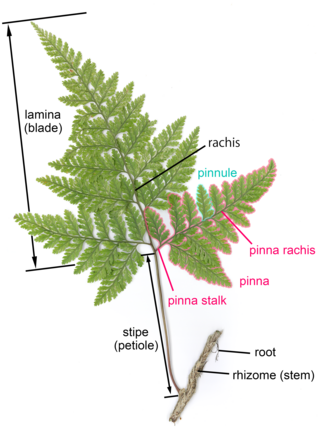
A frond is a large, divided leaf. In both common usage and botanical nomenclature, the leaves of ferns are referred to as fronds and some botanists restrict the term to this group. Other botanists allow the term frond to also apply to the large leaves of cycads, as well as palms (Arecaceae) and various other flowering plants, such as mimosa or sumac. "Frond" is commonly used to identify a large, compound leaf, but if the term is used botanically to refer to the leaves of ferns and algae it may be applied to smaller and undivided leaves.
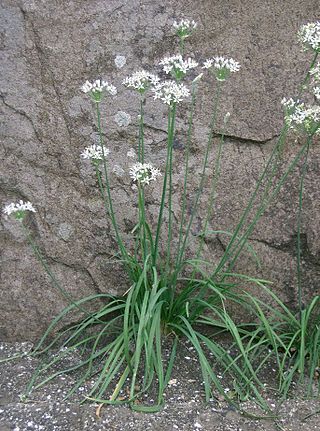
Allium tuberosum is a species of plant native to the Chinese province of Shanxi, and cultivated and naturalized elsewhere in Asia and around the world.

Chlorophytum comosum, usually called spider plant or common spider plant due to its spider-like look, also known as spider ivy, ribbon plant, and hen and chickens is a species of evergreen perennial flowering plant of the family Asparagaceae. It is native to tropical and Southern Africa but has become naturalized in other parts of the world, including Western Australia and Bangladesh. Chlorophytum comosum is easy to grow as a houseplant because of its resilience, but it can be sensitive to the fluoride in tap water, which commonly gives it "burnt tips". Variegated forms are the most popular.

Allium vineale is a perennial, bulb-forming species of wild onion, native to Europe, northwestern Africa and the Middle East. The species was introduced in Australia and North America, where it has become a noxious weed.

In biology, stolons, also known as runners, are horizontal connections between parts of an organism. They may be part of the organism, or of its skeleton. Typically, animal stolons are exoskeletons.
Edible plant stems are one part of plants that are eaten by humans. Most plants are made up of stems, roots, leaves, flowers, and produce fruits containing seeds. Humans most commonly eat the seeds, fruit, flowers, leaves, roots, and stems (e.g. [asparagus] of many plants. There are also a few edible petioles such as celery or rhubarb.

The sand leek, also known as rocambole and Korean pickled-peel garlic, is a Eurasian species of wild onion with a native range extending across much of Europe, Middle East, and Korea. The species should not be confused with rocambole garlic, which is A. sativum var. ophioscorodon.

In botany, a peduncle is a stalk supporting an inflorescence or a solitary flower, or, after fecundation, an infructescence or a solitary fruit. The peduncle sometimes has bracts at nodes. The main axis of an inflorescence above the peduncle is the rachis. There are no flowers on the peduncle but there are flowers on the rachis.
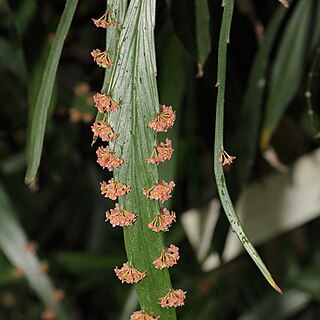
Phylloclades and cladodes are flattened, photosynthetic shoots, which are usually considered to be modified branches. The two terms are used either differently or interchangeably by different authors. Phyllocladus, a genus of conifer, is named after these structures. Phylloclades/cladodes have been identified in fossils dating from as early as the Permian.

In botany, a pedicel is a stem that attaches a single flower to the inflorescence. Such inflorescences are described as pedicellate.
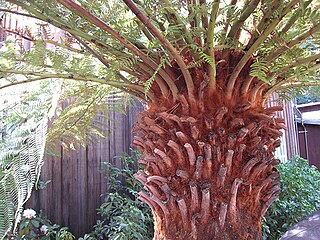
A caudex of a plant is a stem, but the term is also used to mean a rootstock and particularly a basal stem structure from which new growth arises.
This page provides a glossary of plant morphology. Botanists and other biologists who study plant morphology use a number of different terms to classify and identify plant organs and parts that can be observed using no more than a handheld magnifying lens. This page provides help in understanding the numerous other pages describing plants by their various taxa. The accompanying page—Plant morphology—provides an overview of the science of the external form of plants. There is also an alphabetical list: Glossary of botanical terms. In contrast, this page deals with botanical terms in a systematic manner, with some illustrations, and organized by plant anatomy and function in plant physiology.

Scadoxus is a genus of African and Arabian plants in the Amaryllis family, subfamily Amaryllidoideae. The English names blood lily or blood flower are used for some of the species. The genus has close affinities with Haemanthus. Species of Scadoxus are grown as ornamental plants for their brilliantly coloured flowers, either in containers or in the ground in frost-free climates. Although some species have been used in traditional medicine, they contain poisonous alkaloids.
This glossary of botanical terms is a list of definitions of terms and concepts relevant to botany and plants in general. Terms of plant morphology are included here as well as at the more specific Glossary of plant morphology and Glossary of leaf morphology. For other related terms, see Glossary of phytopathology, Glossary of lichen terms, and List of Latin and Greek words commonly used in systematic names.

A stem is one of two main structural axes of a vascular plant, the other being the root. It supports leaves, flowers and fruits, transports water and dissolved substances between the roots and the shoots in the xylem and phloem, stores nutrients, and produces new living tissue. The stem can also be called halm or haulm or culms.

In botany, a whorl or verticil is a whorled arrangement of leaves, sepals, petals, stamens, or carpels that radiate from a single point and surround or wrap around the stem or stalk. A leaf whorl consists of at least three elements; a pair of opposite leaves is not called a whorl.
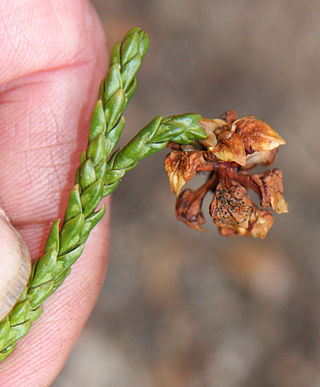
In plant morphology, a cataphyll is a reduced, small leaf. Many plants have both "true leaves" (euphylls), which perform most of the photosynthesis, and cataphylls, which are modified to perform other functions.

Symphyotrichum kentuckiense is a rare species of flowering plant in the Asteraceae family and is commonly known as Kentucky aster, Price's aster, Miss Price's aster, Sadie's aster, or lavender oldfield aster. It is a perennial, herbaceous plant that is endemic to broken limestone cedar glades and roadsides in Alabama, Georgia, Kentucky, and Tennessee. It blooms from August through October, reaches heights between 30 centimeters and 100 cm (3.3 ft), and has green to reddish-brown stems. It is a nearly hairless plant with blue to blue-violet ray florets.



















